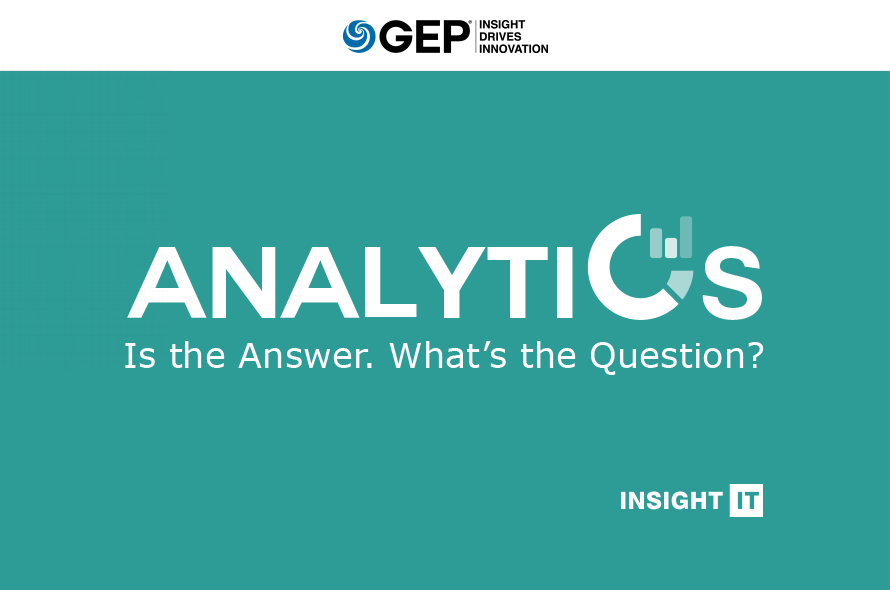The crux of all digitalization programs is data. And as enterprises focus on digital business transformation, they are generating more data than ever before. How do you convert the huge volumes of structured as well as unstructured data into actionable intelligence?
Powerful new analytics tools with AI and big data capabilities can do this at scale. But, the key to success is asking the right questions.
GEP’s latest Insight IT white paper, Analytics Is the Answer — What’s the Question? helps CIOs and IT professionals understand how advanced analytics tools can help enterprises unlock next-level business intelligence from their data. It also explains how data lakes will power a new breed of analytics solutions that provide unprecedented enterprise-wide intelligence.
Why Read It:
- Getting answers is just the beginning — discover how analytics can help you ask the right questions
- How AI and big data can help you create value across the supply chain
- The role of data lakes in driving innovation in analytics
Read today to understand how you can build advanced analytics capabilities for your enterprise.
Although the terms “analysis” and “analytics” are often used interchangeably, they are quite different. Analysis is a relatively straightforward act that can be performed by either a human or a machine; while in the context we will be discussing, analytics can only be carried out with the support of technology.
Analysis is the process of taking something apart, or breaking it down into its component parts, to better understand its overall meaning and function. It could be argued that analytics is fundamentally different in approach; it brings data sets together into one larger set that is normalized and processed, the goal being to discover meaning and function through trends and patterns that would be difficult to uncover with less data.
In business, analytics allows us to address more data, more complexity, and tougher questions — hopefully at a very high rate. Today, advanced analytics is more than just the ability to get answers to the questions we already have. It provides guidance and observations as to the questions we should be asking based on the data and constraints we feed it.
The Right Questions
Knowing which questions to ask drives 90 percent of the value we receive from any level of analysis. Uncovering those questions can be time-consuming if humans are left to their own capabilities, but with the assistance of technology we can extract even more value in near real time and with fewer limiting assumptions.
In the world of procurement and supply operations, asking a question such as “Should I renegotiate this category of spend now?” presupposes a number of constraints or rules that may or may not be valid — and that we do not realize we are inserting into the process. It assumes that the category in question is the right scope for a project. It assumes that negotiation or renegotiation is the optimal approach to spend and supplier

management. It even assumes that the product or service should continue to be purchased in its current form, or is even still in demand.
With the assistance of analytics, we can base our questions on patterns and outliers located within the data itself, no matter how much of it there is. The paradox is, the more data we have at our disposal, the more difficult it is to observe these patterns organically. Hence the need for a new technology solution.
The next wave of analytical capabilities will allow businesses to drive a new class of questions, with almost no historically-oriented assumptions or biases baked in.
With the ability to extend regular patterns and anticipated outliers into the future, companies can also engage in preemptive strategies to build customer loyalty, secure opportunistic pricing, and even mitigate supply chain disruption.
The Role of the Data Lake
Predictive capabilities are the obvious extended application for analytics, but they are not the only one. There has been growing interest in the combined potential of analytics and “data lakes” in the wake of widespread experimentation with big data.

The advent of the data lake as a concept is driving new innovations in analytics and building our understanding of the connections between how we store data and how it can be used in the future. Rather than just being a new way of describing big data or data warehouses, data lakes are unique because they are centralized repositories of data that are not touched until they are queried.
If a data warehouse is used for storing structured and packaged data from different sources in a highly ordered and easy-to-access framework, much like a physical logistics warehouse, then a data lake allows those different sources to flow directly — and unchanged — into a single repository. Just like a natural lake, the “processing” happens when we take the data out to use it.
Reimagining Analytics as We Know It
This change in approach to data acquisition and storage is enabling new types of analytical systems to become reality. Just like the assumptions about sourcing a category of spend, the way we structure data on the way into a data warehouse presupposes how we will apply it later. We may unintentionally eliminate types of analysis that we never expected to conduct. Leaving the data largely untouched and unprocessed means we can interact with it in unforeseen ways if an opportunity arises. And if there is anything we have learned through the advancing capabilities of technology, it is that we should expect (and prepare for) the unexpected.
From a practical standpoint, advanced analytics allow us to ask not only different questions but a different class of questions entirely. Today, it may seem innovative to be able to ask a procurement system, “Which categories should I renegotiate?” While that is fairly advanced compared to what we could do just five years ago, in the near future we will be able to ask, “What activities will bring the greatest ROI given my current constraints and objectives?” This different class of question will lead to different ways of thinking about how we work and what we work on. The emergence of big data, artificial intelligence (AI) and other cognitive technologies will pave the path for next-level business analytics, at scale.
Summing It Up
- Analytics doesn’t just help us do a better job getting the answers to our questions, it also helps us understand what questions we should ask.
- Asking the right questions, and doing so without human-imposed assumptions and biases, allows us to derive optimal insights from our data.
- While predictive analytics makes it possible to prepare for the future based on extensions of historical data, data lakes ensure that our data is not hamstrung by structures of the past when the time comes to apply it.
- Emergence and development of big data, AI and other cognitive technologies would enable next-level business analytics.
Why It Matters in Procurement and Supply Chain
The volume capabilities of advanced analytics will allow procurement and supply chain teams to expand beyond their own data into operational, sales, and potentially even marketing data. Being able to incorporate demand projections, real-time inventory levels, and orders in the pipeline will bring the activities of these two critical functions into greater alignment enterprise-wide.

